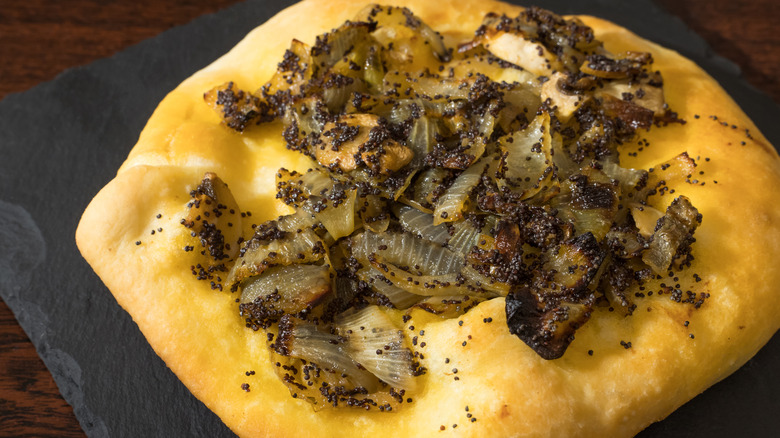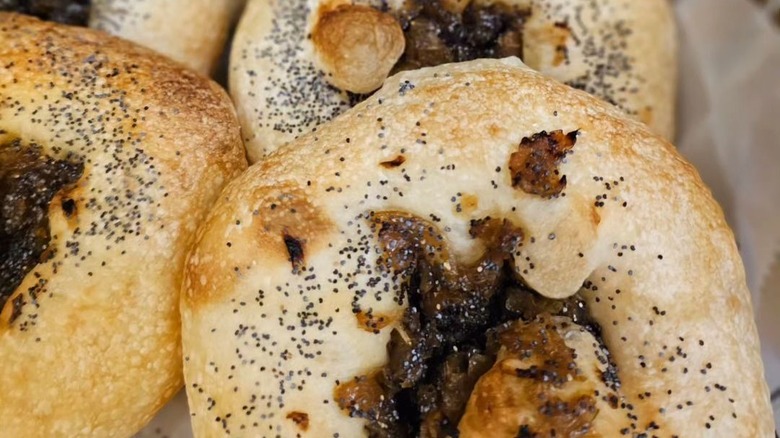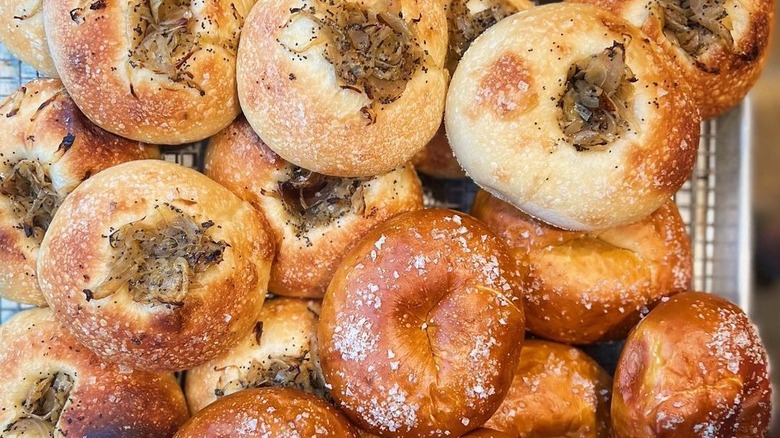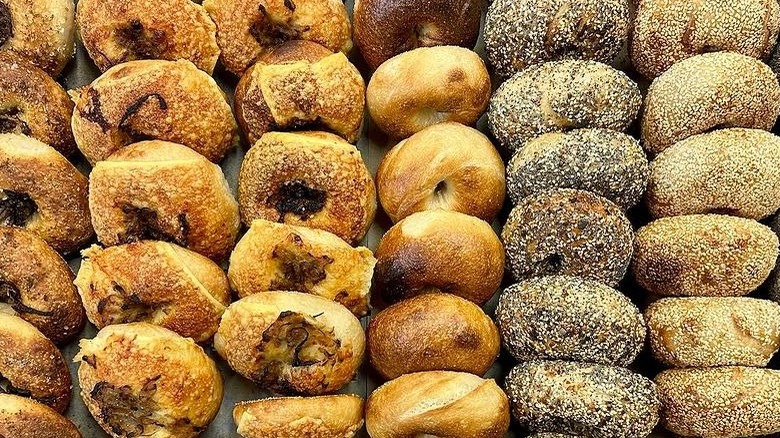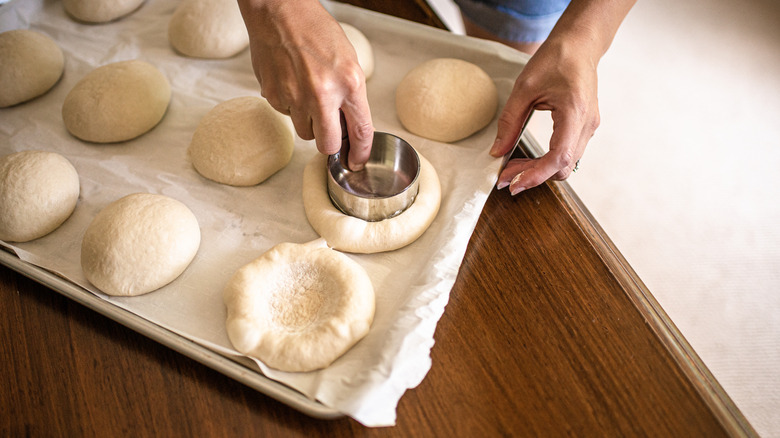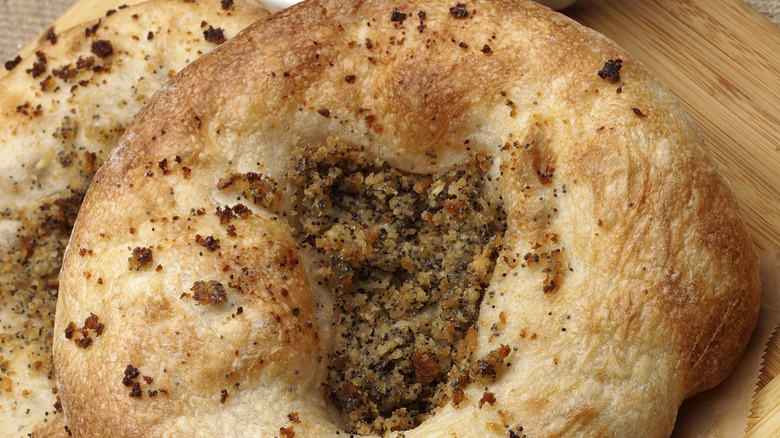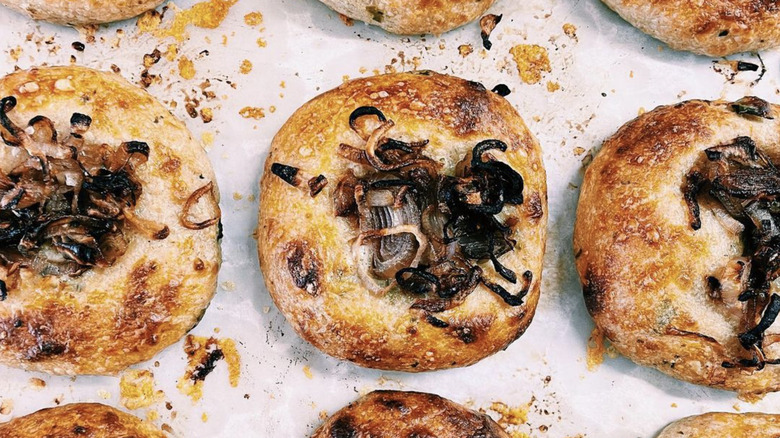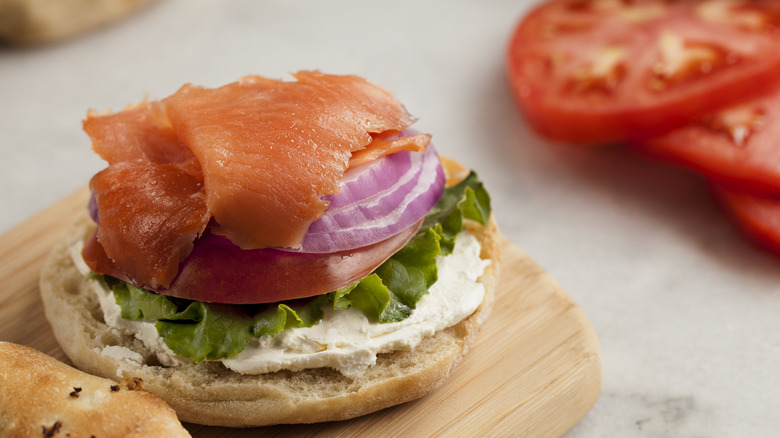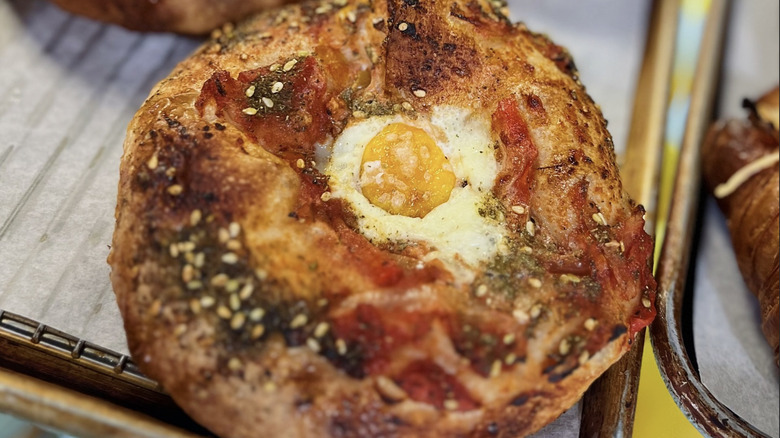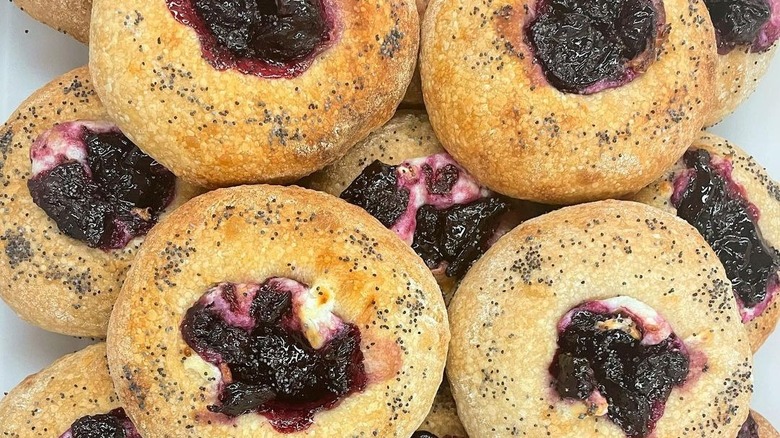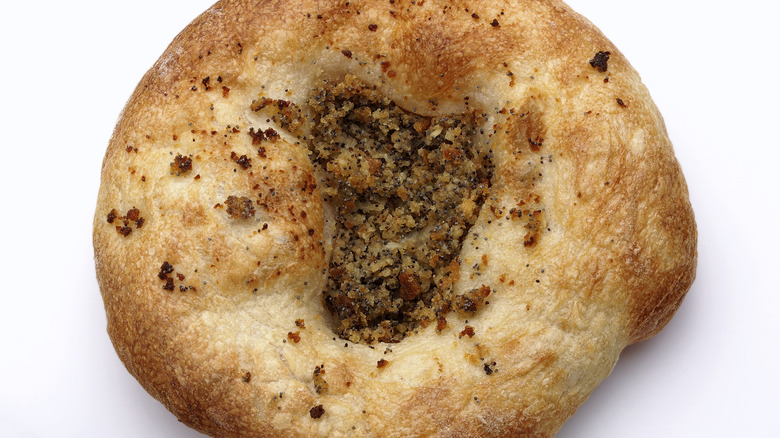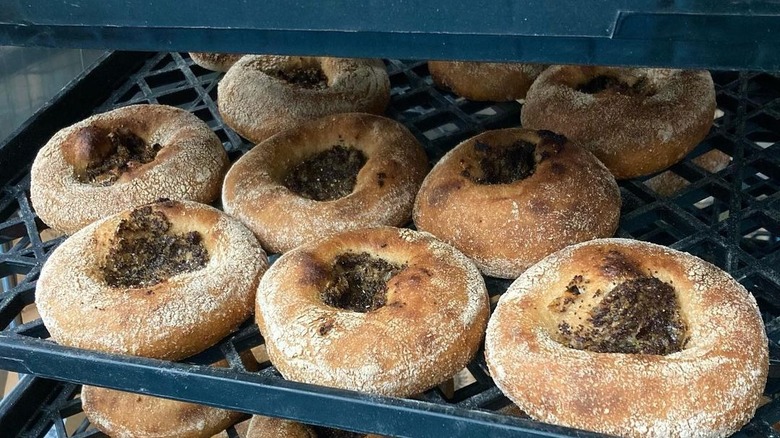What Is A Bialy And How Do You Eat It?
Every morning, breakfast presents us with a wealth of fabulous baked goods to choose from as we start our day. There are waffles and muffins, donuts and coffee rolls, and — of course — all varieties of toast. But, if you want to supercharge that first meal of the day with something that's packed with flavor and is a little more unusual and outside the box than a serving of whatever you picked up in your local supermarket's bakery aisle, look no further than the incredible bialy!
Like a cross between the best parts of an English muffin and a bagel, this Jewish delight (pronounced be-ALL-e) is a rare and somewhat elusive treat. Most bialys are around three to four inches in diameter and round. They look similar to a bagel but with a flatter profile. And, instead of a hole, bialys have a deep, impressive depression in their center. More than just a baker's trick to help bialys bake more evenly, this crevice is ultimately what gives a bialy its unique identity and can be filled with a variety of different savory toppings, including caramelized onions, olives, cheeses, creamy fillings, and more.
Similar to other bakery favorites, Bialys are made from a simple dough of traditional ingredients, including flour, water, yeast, and salt. The dough is allowed to rise before being baked, giving the bialys a chewy, tender, and slightly crispy texture that is wonderful on its own and pairs well with an incredible variety of other foods.
What does a bialy taste like?
When freshly baked, a bialy has a crust that's golden brown and slightly crispy on the outside. It provides a delightful crunch as you bite in. Inside that hardened exterior lies a pillowy soft center. Bialys are moist and satisfying, with a dense, airy chewiness. They also have an exceptionally unique flavor profile that sets them apart from other varieties of bread. You get hints of nuttiness and sweetness in the crust. Inside, the moist middle layer of the bialy has a noticeable tang that's similar to the bite you get from a rich sourdough bread. Imagine eating a ball of baked pizza dough without any toppings — that's a good way to think of the bialy experience.
But, that's also just the dough portion of the bialy. Don't forget that waves of flavor also come from the variety of fillings baked into the bialy's center. Caramelized onions are one of the most common and widely loved toppings. Heaped in the center by the spoonful, these onions give any bialy a rich, savory, umami flavor. You can also find fillings like diced olives or rich melted cheeses in bialys, as well. Both only add to the wonderful, decadent quality of the bread, giving it hints of saltiness and depth. Combine that vibrant flavor with the extraordinary aroma that bialys provide — a whiff of warm, yeasty comfort — and their beautiful, distinctive, golden crusts, and this East Coast favorite is truly a feast for all the senses.
A brief history of the bialy
According to food historians, the rise of the bialy can be traced back to 19th century Poland, and perhaps even earlier. One popular theory suggests that a Polish baker may have dropped some dough, stepped on it — creating that distinctive impression in the bialy's center — and decided to bake it anyway, not wanting to waste the precious resource.
We'll never know whether or not that's true. What we do know is that by the late 1800s, bialys were incredibly popular and beloved throughout Poland, showing up in bakeries on almost every corner. When Polish immigrants traveled to the U.S. in the early 1900s, they brought the recipe for this regional favorite with them. For a time after that, in places like New York's Lower East Side (a.k.a. "Bialy Central"), the baked goods were said to be sold almost everywhere. Their popularity has sadly faded since that peak, yet they remain integral to both the NYC and worldwide Jewish culinary scene.
As for the name bialy, it's not actually a translation or anything that has another meaning. Instead, it's based on the name of the town where the bread was first created — Białystok, Poland. Located in the northeastern part of the country (near Poland's border with Belarus) on the banks of the Biała River, the city has a rich history that dates back to the Stone Age. Talk about historic!
Bialys vs. bagels
Bialys and bagels have a lot in common, but they're also very distinct and unique from one another in special ways. They're a bit like those twins in The Parent Trap — they have the same genetics but were raised in very different ways. Both baked goods originated in Poland, and the dough for both typically starts with the same essential ingredients. From there, the differences mount considerably.
Bagels are typically boiled briefly in water before being baked. This unusual step is part of what makes bagels so different from bread and is also responsible for helping to create their distinctive, chewy texture and glossy crust. In contrast, bialys are typically baked in the oven without boiling. This is why they have a softer, more pillowy texture inside than a bagel.
Also, in perhaps the most prominent visual difference between the two, bagels have that distinctive doughnut-like hole in their center. Bialys are whole. They're flatter and slightly smaller than bagels, with that unique indentation in their center. They also tend to have a more rustic appearance. And, of course, they're filled.
Bagels and bialys rarely have ingredients mixed into their dough. Instead, those garnishes — sesame, poppy seeds, or everything seasoning — tend to be added to both bread's exteriors before they are cooked. Yet, beneath those flavorings, a plain bagel and a plain bialy taste reasonably similar. Their textures will be different, but their dough itself is wheaty, light, and relatively neutral with a subtle, earthy tang.
How bialys are made
If you can make dough, you can likely also make homemade bialys from scratch. The process starts with mixing flour, yeast, salt, sugar, and warm water to make a dough that will form the bialys. Once the dough is formed and kneaded thoroughly, it's left to sit in a warm place, during which time it will rise nicely and double in size.
After the dough has risen, bakers punch it down to remove any potential air bubbles and then divide it into equal portions, shaping each into a ball. These dough balls are placed on a parchment-lined baking sheet, covered with a kitchen towel, and left to rise again. Once the dough has rested, it's time to create that indention in the center of the bialy. This can be done with the baker's fingertips, the bottom of a heavy glass, or any other tool that will press an even indention into the dough, leaving a slight rim around the bialy's edge.
Next, the bialy is filled with caramelized onions, creamy cheese, or whatever else the baker has in mind for each batch. Once the filling is in place, the bialy goes straight into a warm oven. It's left there to rise, bake, and turn a beautiful golden brown.
The most common varieties of bialys
Bialys topped with caramelized onions tend to be one of the most common varieties you'll find in markets or bakeries. But, dig a bit deeper into the world of this fantastic baked good, and you're likely to find a wide variety of flavors to pick from — it's a vastness that rivals even that of more commonly encountered (and just as versatile) bagels.
Poppy seeds are a popular bialy topping. The tiny bursts of blackened goodness are often sprinkled on top of bialys before baking, adding a nutty flavor and crunchy texture to the dough. There are also bialys that swap that onion center for a topping of roasted garlic. The center of bialys can also commonly be filled with melted cheeses, such as cheddar, Swiss, or Brie. Or, your bialy might contain a pesto-like center made with fresh parsley, dill, thyme, or rosemary.
Some bakers have been known to add chopped sun-dried tomatoes or even crispy crumbled bacon to the center of their bialy. Scallions and ham can also be used. There are Italian pizza–style bialys topped with generous mounds of pepperoni and mozzarella. And, of course, for those who like it hot, you can also sometimes find bialys topped with a variety of peppers, from mild, sweet roasted red and yellow bell peppers all the way up to uber hot jalapeños, habaneros, and beyond.
Traditional ways to eat a bialy
When they were popularized, a bialy might have been your entire meal. Fresh from the oven, they were typically served with butter or soft cheese. Depending on your overall hunger — or level of wealth — that bialy might have also been paired with some cured or smoked herring or, if you were in the mood for sweets, something like a treat known as halvah (essentially, a fudgy, candy-like mixture of sugar, honey, and nuts).
Flash forward to today, and bialys are eaten much more like a bagel. You might shmear on some cream cheese or butter, or maybe top yours with a bit of lox. Of course, a bialy is best enjoyed when still nice and warm and fresh from baking. Sometimes, that just isn't possible.
Because of its filling and shape, most bialys will never fit in a toaster. To heat yours, you could either warm it in the oven — place the bialy directly on the rack in an oven preheated to 350 degrees Fahrenheit — and let cook for five to seven minutes, or until heated through and crispy. Or, try warming yours in a toaster oven, air fryer, or even a stovetop panini press. You could also use your broiler. Let it preheat, place the bialy on a baking sheet, and then broil for one to two minutes per side, until heated through and lightly crispy. Eat the bialy on its own or pair it with your favorite breakfast eggs and meats.
Bialy sandwiches
From egg and sausage on an English muffin to filled croissants and carbonara breakfast sandwiches, breakfast is all about mouthwatering pairings of bread, meat, and cheese. While a bialy might not be the first thing you think of when making a sandwich, maybe it should be — for breakfast, or any time of day or night!
With their thick, crispy crust, chewy interior, and built-in pocket (ideal for spreads and condiments), bialys are an ideal vehicle for sandwiches of all types. Consider the joy of starting your day with bacon, scrambled eggs, and melted cheese on a toasted bialy. Or, how about thinly sliced smoked salmon, cream cheese, red onion, and capers? If you don't eat meat, you could even go for mashed avocado, sliced tomato, crumbled feta cheese, and a drizzle of balsamic glaze on that toasted bialy.
Bialy sandwiches aren't just for breakfast. Kick back at lunch with sliced pepperoni, marinara sauce, melted mozzarella cheese, and black olives on your toasted poppyseed bialy. You could also make a BLT bialy with bacon, lettuce, tomato, and mayo on a toasted onion–topped bialy. For dinner, the options are just as vast: You could make a sandwich with turkey breast, cranberry sauce, and creamy brie; hummus, roasted red peppers, cucumber, and mixed greens; or even shredded barbecue chicken, caramelized onions, coleslaw, and pickles. Our personal favorite is a pastrami and Swiss bialy, made with thinly sliced pastrami, melted Swiss cheese, sauerkraut, and creamy Russian dressing. Yum!
Other ways to enjoy a great bialy
When you tire of sandwiches, there are still countless other ways in which you can enjoy a bialy. If you think of them like bread, you can use them in just the same way you would any other slice — in a melted panini, grilled cheese, or even French toast (depending on the bialy's topping). Bialys are also a fantastic canvas for a wide variety of other culinary creations. You might make bialy pizza bites, for example. Just slice the bialy into bite-sized pieces, top with pizza sauce, shredded cheese, and your favorite toppings, then bake until the cheese is melted and the bread is crispy and golden.
In the mood for bruschetta? Make it with bialys, instead. Just cut a couple of bialys in half, toast until lightly crispy, and then top each slice with a mixture of diced tomatoes, garlic, basil, olive oil, and balsamic vinegar. Bialys also pair fantastically with soup. You can either dip your bialy in whole or cut it into thick slices, toss the slices with olive oil, garlic powder, and Italian seasonings, and then bake until crispy. Then, dip those "croutons" into your favorite soup, chowder, or homemade chili.
And, don't forget that the space on top of the bialy is also great for all sorts of DIY add-ons, from spinach dip to tuna salad to spoonfuls of scrambled eggs, taco toppings, or even soupy pasta (think of the bialy as a mini, shallow bread bowl).
Bialy desserts you have to try
It would be a big mistake to assume that bialys can only be savory. Sure, if the bialy you buy is topped with olives or onions, then you probably don't want to spread a bunch of frosting on top. But, cream cheese, poppyseed, and nut-topped bialys can be an incredible base for a wide variety of quick and easy sweet desserts. For instance, any sweetened cream cheese you put on a bagel — from berry-flavored options to cinnamon and honey cream cheeses — will taste great on a bialy.
You can also quickly turn a warm, toasted bialy into a make-shift tart by topping it with sliced fruit (strawberries, bananas, or peaches), chopped almonds or pecans, and a drizzle of honey or maple syrup. Or, smear creamy chocolate hazelnut spread on a toasted bialy and then pile on sliced bananas or strawberries.
Bialys can also be used for a quick, berry-forward dessert similar to strawberry shortcake. Just top a warm, freshly toasted bilay with a mixture of fresh berries (strawberries, raspberries, or blueberries are ideal) and a generous dollop of homemade whipped cream. For something a bit more elevated and gourmet, top that bialy with tangy lemon curd, fresh berries, and a few mint leaves. Or, go the homey, comfort-food route and make a bialy PB & J. Spread on a few heaping spoonfuls of creamy peanut butter, and then add your favorite flavor of jelly or jam.
The nutritional breakdown of a bialy
The average bialy packs between 180 and 200 calories. This puts it in line with other unsweetened, single-serving baked goods. For example, the average dinner roll or slice of Italian bread is approximately the same — around 200 calories. (With its added sugar, a cinnamon roll comes in closer to the 300-calorie mark, for comparison's sake.)
Because they are essentially just flour, yeast, and salt — plus whatever topping has been added — bialys don't pack a ton of vitamins and nutrients. They're relatively low in fat — two to three grams — unless you add a spread. They also have some protein, around five to seven grams, depending on the type of flour used. Most of the nutrients in a bialy come in the form of carbs (35 to 40 grams per bialy, on average). If the bialy is made with highly processed flour, its fiber count won't be that significant. But, if the baker uses less processed or fortified flour in their dough, then a bialy could provide a couple of grams of fiber or more.
As for fillings, veggies like olives or onions will provide just a slight increase to those totals. However, if your bialy contains a cream cheese or cheese-based center, then levels of fat and protein (as well as overall calories) will increase considerably. A bialy with cream cheese, for example, has closer to 230 calories, 38 grams of carbs, seven grams of protein, and three grams of total fat.
Where to buy bialys
Traditionally made bialys are said to have a relatively short shelf life of about six hours — perhaps that's one reason they never became as widespread as bagels. Still, if you want to enjoy all the tangy, savory flavor packed into one of these baked wonders, there are plenty of ways to track one down. If you live in New York City or will be visiting this tourist mecca in the future, you should have no trouble finding bialys in their native habitat — especially if you trek to any of the many bakeries in the Lower East Side. Just get there early to beat the lines!
Outside of NYC, bialys are widely available in many cities with large Jewish populations, like Chicago, Los Angeles, Miami, Washington D.C., and Philadelphia. Jewish delis in these cities often carry fresh bialys alongside other traditional Jewish bread and pastry items. You can also regularly find fresh bialys in specialty grocery stores or markets catering to Eastern European or Jewish communities. They're also a favorite at many farmer's markets and food festivals.
Still no luck? If your bialy search has hit a rut, consider mail order. Many online retailers specialize in shipping traditional Jewish foods like bialys nationwide. There are also gourmet subscription boxes that regularly include bialys as part of their monthly offerings. If all that fails, you can always make your own homemade bialys. It's easier than you might think and could become a new go-to favorite.

